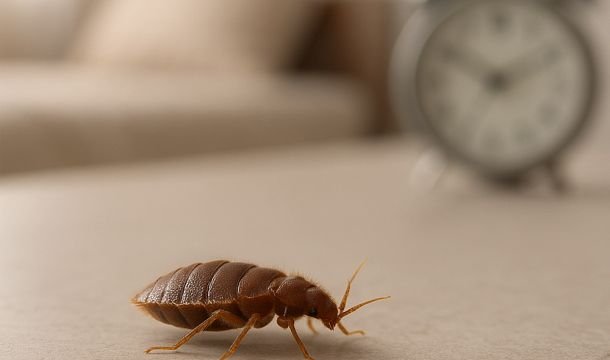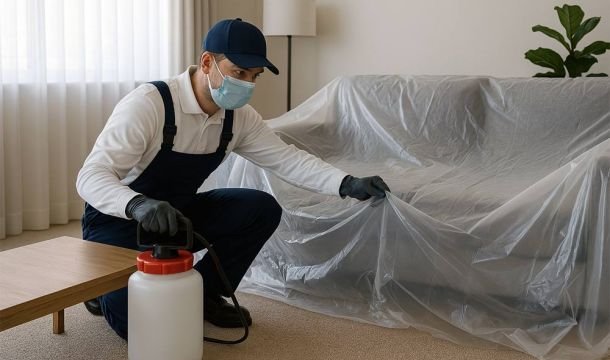Can Bed Bugs Come Back After Professional Treatment? Prevention Steps That Work
If you’ve recently completed professional bed bug treatment, you’re likely wondering: can bed bugs come back after professional treatment? The short answer is yes – they can. Research published in the Journal of Medical Entomology indicates that up to 30% of successfully treated homes experience bed bug recurrence within one year (Doggett & Russell, 2022). However, there’s good news: most of these re-infestations are entirely preventable with the right post-treatment approach.
This comprehensive guide explains why bed bugs might return after professional treatment and provides proven strategies to ensure these persistent pests don’t make a comeback in your home.
Why Bed Bugs Can Return After Professional Treatment
Several factors can contribute to bed bug recurrence:
- Missed bugs or eggs during treatment – Even thorough treatments might miss well-hidden bugs
- Eggs hatching after treatment – Some treatments don’t kill eggs, which can hatch 6-10 days later
- Reintroduction from outside sources – Bringing new bed bugs home from travel, visitors, or used items
- Neighboring infestations – In multi-unit buildings, bed bugs can migrate through walls from nearby units
- Insufficient follow-up – Lack of monitoring and preventative measures after initial treatment
Understanding these risk factors is the first step toward ensuring bed bugs stay gone for good.
The Critical First 72 Hours: Preventing Immediate Return
What you do immediately after treatment significantly impacts whether bed bugs will return:
1. Follow Re-Entry Instructions Precisely
- Wait the full recommended time before re-entering your home
- For chemical treatments: typically 4-6 hours minimum
- For heat treatments: until the home has cooled to normal temperature
- Air out the home if recommended by your pest control professional
2. Keep Treated and Untreated Items Separated
- Do not return laundered items to treated areas immediately
- Keep sealed bags of clean clothing and linens separate until instructed
- Maintain clear separation between treated and untreated items
3. Perform Initial Post-Treatment Clean-Up
- Vacuum all areas thoroughly, including:
- Carpet edges and baseboards
- Furniture seams and crevices
- Mattress seams and box springs
- Dispose of vacuum bags in sealed plastic bags outside your home
- Wipe down all surfaces where dead bed bugs might be present
Weeks 1-2: Crucial Monitoring to Catch Returning Bed Bugs Early
Early detection is key to preventing a full-scale return. During the first two weeks:
1. Install Monitoring Devices to Detect Survivors
- Place interceptor traps under all bed and furniture legs
- These cup-shaped devices trap bed bugs trying to climb up or down
- Check these every 2-3 days initially
- Consider active monitors that use CO₂ or heat as attractants for early detection
- Place the interceptors under bed or close to bed legs.
2. Create Protective Barriers Against Surviving Bugs
- Encase all mattresses and box springs in quality bed bug-proof covers
- Look for products specifically labeled as bed bug-proof, not just allergen-proof
- Ensure the zipper area is protected with a secure seal
- Keep beds pulled away from walls (at least 6 inches)
- Ensure no bedding touches the floor to create a “moat” effect
3. Continue Vigilant Laundering to Eliminate Stragglers
- Maintain hot washing and drying protocols for:
- Bedding (wash weekly at minimum)
- Clothing worn in potentially infested areas
- Any fabric items brought back into the home
Months 1-3: Preventing Long-Term Recurrence
1. Establish Regular Inspection Routine
Set a regular inspection schedule to catch any signs of return:
- Weekly for the first month
- Bi-weekly for the second month
- Monthly thereafter
During these inspections, check these common hiding places:
- Mattress seams, tags, and piping
- Box spring edges and underneath
- Bed frame joints and headboards
- Upholstered furniture seams and cushions
- Behind picture frames and wall hangings
- Inside electrical outlets and switch plates (visual check only)
- Baseboards and carpet edges
2. Maintain Physical Barriers
- Keep interceptor traps in place for at least 6 months
- Do not remove mattress and box spring encasements (they trap any surviving bugs inside)
- Consider applying diatomaceous earth in strategic, hidden locations
- Along baseboards
- Under appliances
- Behind electrical outlets (consult an electrician)
3. Prevent Reintroduction With Home Protocols
Create and enforce household rules to prevent bringing new bed bugs home:
- All luggage after travel (see travel section below)
- Second-hand furniture and clothing (inspect and treat before bringing inside)
- Packages and deliveries during high-risk periods
- Visitors’ belongings from potentially infested locations
Preventing Re-infestation in High-Risk Scenarios
1. For Frequent Travelers
Travel is one of the most common ways bed bugs return to treated homes. If you travel regularly:
- Keep luggage in the garage or bathtub when returning home
- Immediately wash and heat-dry all clothing from trips
- Consider portable heating units for treating luggage contents
- Store luggage in sealed plastic bags or containers between trips
- Consider using luggage liners specifically designed to prevent bed bug hitchhiking
2. For Those in Multi-Unit Housing
If you live in an apartment or condominium:
- Seal all cracks and crevices along shared walls
- Install door sweeps on all doors
- Apply caulk around pipe entries and electrical outlets
- Consider regular preventative treatments for perimeter areas
- Stay informed about infestations in neighboring units
3. For Homes with Frequent Visitors
If you often have guests or run a home-sharing business:
- Implement a simplified inspection protocol between guests
- Use light-colored bedding to make detection easier
- Consider protective encasements for guest beds
- Maintain a separate laundry protocol for guest bedding
- Leave adequate time between guests for thorough inspection
How to Tell If Bed Bugs Are Coming Back: Warning Signs
Recognize these early warning signs that bed bugs might be returning:
- Unexplained skin welts or itching, particularly in a line or cluster
- Tiny bloodstains on sheets or pillowcases
- Small black spots (fecal matter) on bedding or furniture
- Shed skins (translucent, empty bed bug casings)
- Musty, sweet odor in bedrooms (significant infestations only)
If you notice any of these signs, contact your pest control professional immediately. Early intervention is critical for preventing a full-scale re-infestation.
Professional Follow-Up Services That Prevent Returns
Many reputable pest control companies offer services specifically designed to prevent bed bug returns:
- Scheduled follow-up inspections (often included in treatment packages)
- Monitoring services with regular professional checks
- Maintenance treatments at strategic intervals
- Warranty services that guarantee re-treatment if bed bugs return
Consider these services as insurance against re-infestation, particularly if you:
- Live in a high-risk area with known bed bug problems
- Have experienced multiple infestations in the past
- Travel frequently to high-risk locations
- Live in multi-unit housing where neighbors may have infestations
Long-Term Vigilance: The New Normal
After experiencing a bed bug infestation, some level of continued vigilance becomes part of your routine:
- Seasonal deep cleaning with special attention to bed bug hiding spots
- Maintaining awareness when traveling or purchasing second-hand items
- Keeping basic monitoring tools in place (interceptors, encasements)
- Educating family members about prevention
Yes, Bed Bugs Can Return, But You Can Stop Them
While bed bugs can return after professional treatment, implementing these prevention strategies dramatically reduces your risk. According to research by the University of Kentucky’s Department of Entomology, homes that implement comprehensive post-treatment protocols reduce their re-infestation risk by up to 90% compared to those that take no preventative measures.
If you have questions about specific preventative measures or notice any signs of potential re-infestation, contact a Toronto bed bug control professional immediately. With proper post-treatment care, you can keep your home bed bug-free for years to come.


